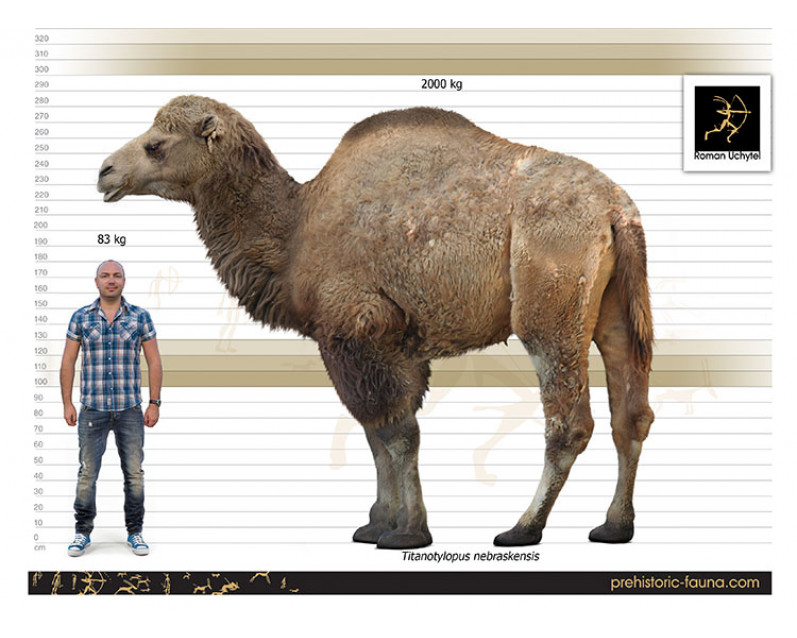Titanotylopus nebraskensis
208208Titanotylopus (Titanotylopus Barbour & Schultz, 1934)
Order: Artiodactyla
Family: Camelidae
Time period: late Miocene - Pleistocene of North America
Size: 3,5 m in length, 280 cm in height, 2000kg of weight
Typical representative: Titanotylopus nebraskensis Barbour & Schultz, 1934
Titanotylopus is an extinct genus of terrestrial herbivore the family Camelidae, endemic to North America from the Miocene through Pleistocene 10.3 mya—300,000 years ago, existing for approximately 10 million years.
Titanotylopus is distinguished from other early large camelids by its large upper canines and other distinguishing dental characteristics, and absence of lacrimal vacuities in the skull. Unlike the smaller, contemporaneous Camelops, Titanotylopus had relatively broad second phalanges, suggesting that it had true padded "cameltoes," like modern camels.
The species Titanotylopus spatulus was characterized by broad, spatula-like incisors. It has been found at Grand View, Red Light, Hudspeth County, Texas, Donnelly Ranch, White Rock, Mullen II (Kansas), Sandahl Local Fauna (Nebraska) and Vallecito Creek, Colorado, 111 Ranch, Arizona in North America.
Titanotylopus possessed long and massive limbs, a comparatively small braincase, and a convex slope between the eyes. Its average height was 3.5 metres. Like modern camels, it possessed a hump for fat storage; evidence for this is provided by the long neural spines on its thoracic vertebrae.
Titanotylopus (Titanotylopus Barbour & Schultz, 1934)
Order: Artiodactyla
Family: Camelidae
Time period: late Miocene - Pleistocene of North America
Size: 3,5 m in length, 280 cm in height, 2000kg of weight
Typical representative: Titanotylopus nebraskensis Barbour & Schultz, 1934
Titanotylopus is an extinct genus of terrestrial herbivore the family Camelidae, endemic to North America from the Miocene through Pleistocene 10.3 mya—300,000 years ago, existing for approximately 10 million years.
Titanotylopus is distinguished from other early large camelids by its large upper canines and other distinguishing dental characteristics, and absence of lacrimal vacuities in the skull. Unlike the smaller, contemporaneous Camelops, Titanotylopus had relatively broad second phalanges, suggesting that it had true padded "cameltoes," like modern camels.
The species Titanotylopus spatulus was characterized by broad, spatula-like incisors. It has been found at Grand View, Red Light, Hudspeth County, Texas, Donnelly Ranch, White Rock, Mullen II (Kansas), Sandahl Local Fauna (Nebraska) and Vallecito Creek, Colorado, 111 Ranch, Arizona in North America.
Titanotylopus possessed long and massive limbs, a comparatively small braincase, and a convex slope between the eyes. Its average height was 3.5 metres. Like modern camels, it possessed a hump for fat storage; evidence for this is provided by the long neural spines on its thoracic vertebrae.

-797x638.jpg)
-797x638.jpg)

-70x56.jpg)
-70x56.jpg)




-346x277.jpg)


